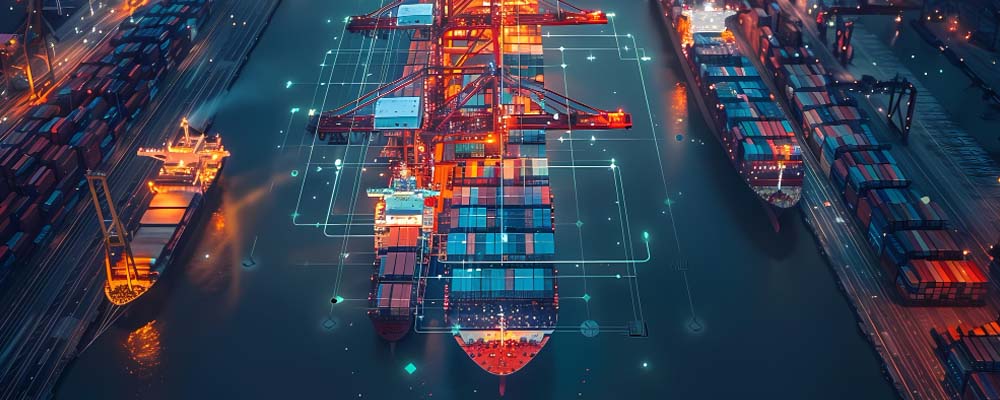
The Port of Los Angeles is a crucial global trade hub, handling more container traffic than any port in the Western Hemisphere. This post explores its operations, infrastructure, economic impact, challenges, and future potential.
Introduction to the Port of Los Angeles
The Port of Los Angeles is a gateway to international commerce, with its strategic location on the U.S. West Coast providing access to major markets in the Asia-Pacific region. As North America’s busiest container port, it handles millions of TEUs annually, serving as a key gateway for global trade and supporting industries like manufacturing, e-commerce, and agriculture.
Key Statistics:
- Location: San Pedro Bay, California, USA
- Area: Over 7,500 acres
- Berths: 25 terminals, including container, liquid bulk, and dry bulk terminals
- Cargo Volume: Over 9.2 million TEUs annually
- Direct Jobs: 1 in 9 jobs in Southern California is connected to the port
- Global Trade Partners: China, Japan, South Korea, Taiwan, and Vietnam
The port’s ability to process such vast quantities of goods and its infrastructure investments make it a crucial node in global trade. But how exactly does the Port of Los Angeles play such an essential role in the world economy? Let’s delve into the technical and analytical aspects.
Port Infrastructure: A Foundation for Global Trade
The Port of Los Angeles boasts world-class infrastructure that is continuously evolving to meet the demands of global commerce. The port’s infrastructure includes not only physical terminals, cranes, and berths but also logistics, data systems, and operational technologies that streamline operations.
Terminals and Berths
Rail and Road Connectivity
A critical part of the port’s efficiency is its connectivity to the inland United States. The Port of Los Angeles features a sophisticated rail network with on-dock yards for direct container transfer from ship to train. This seamless transition is essential for distributing goods efficiently across North America. The port connects efficiently to the interstate highway system, enabling trucks to transport goods quickly to local and regional markets.
- Rail Infrastructure: More than 60% of all containers are transferred via on-dock rail facilities.
- Highway Access: Access to Interstates I-110, I-710, and I-405 provides critical routes to major inland distribution hubs.
Technology and Digitalization
In the era of digital transformation, the Port of Los Angeles has embraced cutting-edge technologies to enhance its competitiveness. The port’s Port Optimizer™ system, developed in partnership with GE Transportation, is a prime example. This cloud-based data platform integrates data from various sources including shipping lines, terminals, and rail operators to improve operational visibility and coordination.
- Port Optimizer™: Provides real-time data on cargo movement, berth schedules, and other key metrics to optimize supply chain performance.
- Automated Terminals: Some port terminals use automation, robotics, and AI to boost efficiency and lower labor costs.
 The Economic Impact of the Port of Los Angeles
The Economic Impact of the Port of Los Angeles
The economic importance of the Port of Los Angeles extends far beyond the confines of Southern California. Its influence touches nearly every corner of the globe, particularly the Asia-Pacific region, which is the primary trade partner for the U.S. West Coast.
Direct and Indirect Jobs
The port supports over 529,000 direct and indirect jobs in the Southern California region. The port generates employment for over 3 million people nationwide, particularly in sectors like manufacturing, transportation, and retail. These jobs range from dockworkers and truck drivers to engineers and logistics specialists.
Trade Volume and Economic Output
In 2023, the Port of Los Angeles handled nearly $276 billion worth of cargo, representing about 9% of all U.S. trade. The majority of this trade is with Asia, with China being the largest trading partner. The port handles approximately 15% of all containerized cargo entering the U.S., underlining its critical role in keeping supply chains flowing and markets stocked with goods.
- Top Commodities: Top imports include apparel, electronics, furniture, and auto parts, while exports consist of recycled materials, agriculture products, and chemicals.
- Revenue Generation: The port generates billions in tax revenue annually for state and local governments through import-export duties and trade tariffs.
Environmental and Sustainability Initiatives
As one of the largest ports in the world, the Port of Los Angeles recognizes its environmental responsibilities. Over the years, it has adopted several initiatives aimed at reducing its carbon footprint, improving air quality, and promoting sustainable operations.
Clean Air Action Plan (CAAP)
The Clean Air Action Plan (CAAP) is a comprehensive strategy launched in partnership with the neighboring Port of Long Beach to reduce port-related air pollution. Since its inception in 2006, the CAAP has helped reduce diesel particulate matter by over 80%, nitrogen oxides by 45%, and sulfur oxides by 97%.
Electrification and Alternative Fuels
The port has made substantial investments in electrifying its infrastructure. Many cranes and terminal equipment now run on electricity, and the port is implementing electric shore power for docked ships. It’s also testing hydrogen trucks to reach zero emissions by 2030.
Environmental Technology Advancement Program
This initiative fosters the development and deployment of cutting-edge technologies aimed at reducing the environmental impact of port operations. The port partners with private sector, government, and academia to test new technologies that could transform logistics and maritime industries.
Challenges Facing the Port of Los Angeles
Despite its many strengths, the Port of Los Angeles faces several challenges that could impact its future role in global trade.
Port Congestion
Port congestion has been a recurring issue, particularly in times of heightened demand, such as during the COVID-19 pandemic. High container volumes sometimes overwhelm the port, causing delays in the global supply chain. While technologies like Port Optimizer™ help, long-term congestion solutions are crucial.
Competition from Other Ports
The Port of Los Angeles faces stiff competition from other ports, both domestically and internationally. Ports on the U.S. East Coast, such as the Port of Savannah, have been expanding their capabilities to attract cargo that would typically be routed through West Coast ports. Additionally, the expansion of the Panama Canal has made it easier for larger ships to bypass West Coast ports altogether.
Labor Relations
Labor relations between port management and dockworker unions, such as the International Longshore and Warehouse Union (ILWU), have historically been a source of tension. Strikes and labor slowdowns can disrupt port operations and create delays, impacting global supply chains. Negotiating long-term labor agreements that balance the interests of workers and port operators is crucial to maintaining stability.
 The Future of the Port of Los Angeles
The Future of the Port of Los Angeles
The port employs over 3 million people nationwide, primarily in sectors such as manufacturing, transportation, and retail.
Expansion and Modernization
The port continues to invest in expanding its capacity, with plans for new terminal developments and upgrades to its rail and road networks. These investments will ensure that the port can accommodate the next generation of ultra-large container vessels and handle increasing trade volumes.
Technological Innovation
The Port of Los Angeles is at the forefront of technological innovation in the maritime industry. From automation and AI to blockchain and big data, the port is exploring new ways to improve efficiency and transparency. Blockchain technology could revolutionize cargo tracking and authentication, boosting security and speed in global trade.
Sustainability Leadership
As environmental regulations tighten, the Port of Los Angeles has an opportunity to position itself as a leader in sustainable port operations. By continuing to invest in green technologies, such as electric vehicles and renewable energy, the port can not only reduce its environmental impact but also set a new standard for ports around the world.
Conclusion
The Port of Los Angeles is a key player in global trade, thanks to its strategic location, advanced infrastructure, and focus on technology and sustainability. To stay competitive, the port must continue innovating and adapting to global logistics trends. For freight forwarders, logistics providers, and manufacturers, understanding the port’s operations is vital for navigating international trade complexities and achieving long-term success.




 The Economic Impact of the Port of Los Angeles
The Economic Impact of the Port of Los Angeles The Future of the Port of Los Angeles
The Future of the Port of Los Angeles



